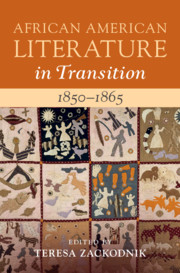Book contents
- African American Literature in Transition, 1850–1865
- African American Literature In Transition
- African American Literature in Transition, 1850–1865
- Copyright page
- Contents
- Figures
- Contributors
- Preface
- Chronology, 1850–1865
- Introduction
- Part I Black Personhood and Citizenship in Transition
- Chapter 1 Freedom’s Accounts
- Chapter 2 Conduct Discourse, Slave Narratives, and Black Male Self-Fashioning on the Eve of the Civil War
- Chapter 3 Picturing Black Authorship with and against Stowe’s Lens
- Chapter 4 African American Periodicals and the Transition to Visual Intercourse
- Part II Generic Transitions and Textual Circulation
- Part III Black Geographies in Transition
- Bibliography
- Index
Chapter 3 - Picturing Black Authorship with and against Stowe’s Lens
from Part I - Black Personhood and Citizenship in Transition
Published online by Cambridge University Press: 07 April 2021
- African American Literature in Transition, 1850–1865
- African American Literature In Transition
- African American Literature in Transition, 1850–1865
- Copyright page
- Contents
- Figures
- Contributors
- Preface
- Chronology, 1850–1865
- Introduction
- Part I Black Personhood and Citizenship in Transition
- Chapter 1 Freedom’s Accounts
- Chapter 2 Conduct Discourse, Slave Narratives, and Black Male Self-Fashioning on the Eve of the Civil War
- Chapter 3 Picturing Black Authorship with and against Stowe’s Lens
- Chapter 4 African American Periodicals and the Transition to Visual Intercourse
- Part II Generic Transitions and Textual Circulation
- Part III Black Geographies in Transition
- Bibliography
- Index
Summary
The complex interaction between the visual and print culture is central to transitions in definitions and perceptions of Black personhood and to an understanding of mid-century African American literature. Marshaled by race science and underwriting the emergence of the periodical as a media form in the United States through its advertisements for fugitives and enslaved Africans for sale, visuality and its imbrication with print were also mobilized by Black authors to contest those racializing scripts through authorial frontispieces. The mid-century explosion of slave narrative publication and the popularization of photographic portraiture are coincident and imbricated, making visuality and viewing practices central to understanding African American autobiographical texts. In this chapter, Michael Chaney focuses on “ex-fugitive” authorial frontispieces between 1850 and 1854 within the frame of what he calls “embedded gazing and looking relations” scripted by the illustration and phenomenal success of Harriet Beecher Stowe’s Uncle Tom’s Cabin. In doing so, he traces contestations over visual compositions of “the slave” that he argues form “the emergence of an ‘optic American slave’” during a “volatile juncture” for African American pictorial self-representation in print culture. How might, and did, Black authors challenge what Chaney calls a “viral Uncle Tom”?
Keywords
- Type
- Chapter
- Information
- African American Literature in Transition, 1850–1865 , pp. 68 - 90Publisher: Cambridge University PressPrint publication year: 2021

